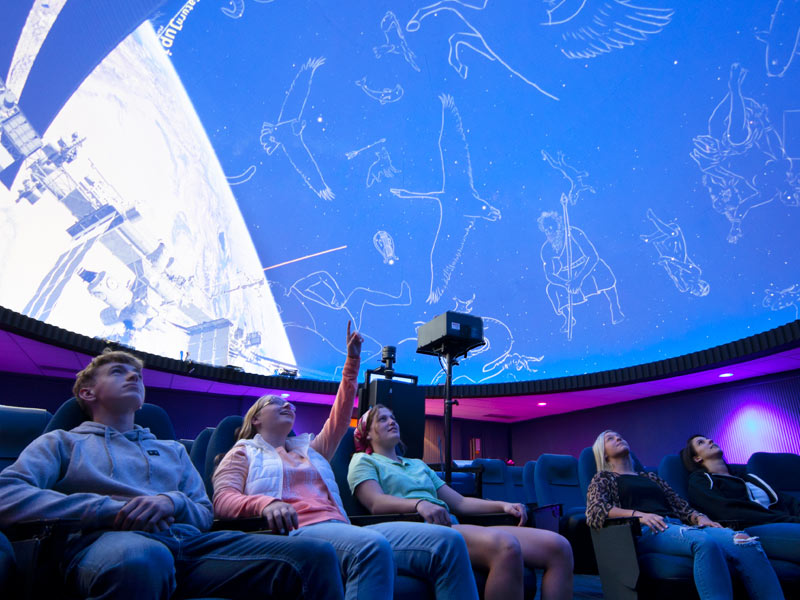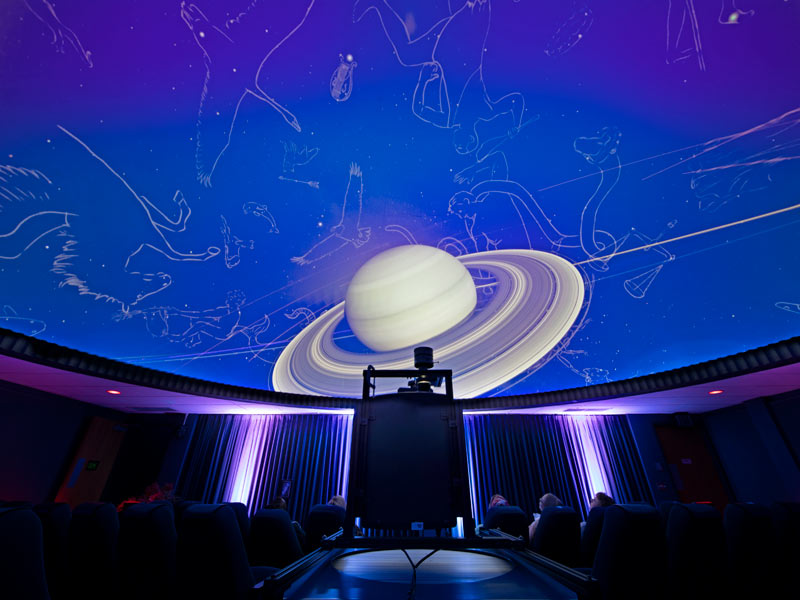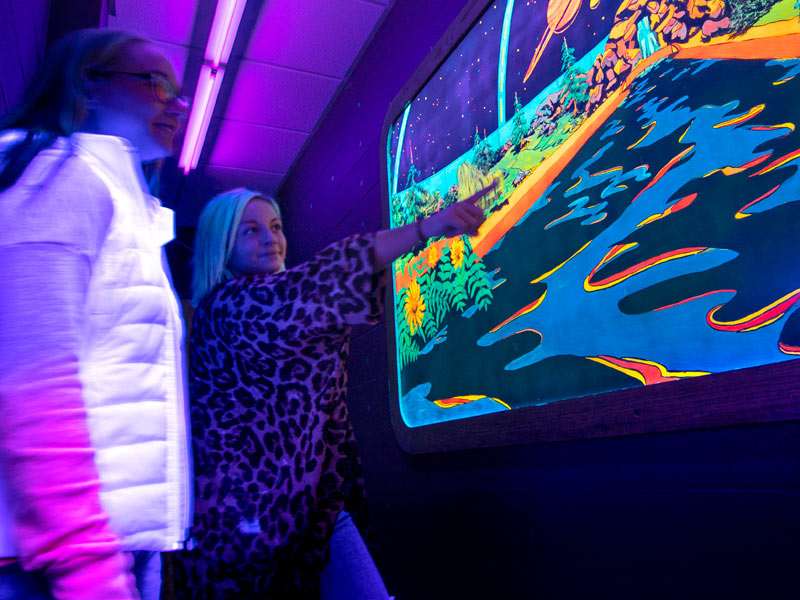The Southwest Minnesota State University Planetarium is a theater of the universe. It can surround you with an accurate image of the sparkling night sky as well as display the complex motions and cycles that take place around us. State-of-the-art technologies create a fully immersive multimedia experience.
The three primary projection systems include a laser phosphor digital full-dome system, an LED-driven optical-mechanical star projector offering the most pristine look at the night sky, as well as a full-color laser light show system that can fill the entire dome with mesmerizing laser light. To augment this experience, a powerful audio system enhances the impact of the experience as you take in the wonders of the cosmos. This unique experience will interpret the universe in a way that appeals to both the mind and the eye. The Planetarium will introduce you to a life-long acquaintance with the sky and the dynamic universe we are a part of.
To book a group planetarium star show and/or laser light show by contacting the planetarium director:
Ken Murphy
ken.murphy@smsu.edu
Follow Us On: Facebook Icon Facebook
| Date | Event |
|---|---|
| 4-Jan | Earth at perihelion, closest point to the sun, 91.4 million miles |
| 5-Jan | Latest sunrise at 7 |
| 14-Jan | 20th anniversary of Huygens probe landing on Saturn’s moon—Titan |
| January 16-18 | Saturn and Venus close in evening sky |
| January ? | Launch of NASA’S Blue Ghost Mission 1, a lunar lander |
| January ? | Launch of JAXA’s (Japan) lunar lander/rover Resilience |
| 29-Jan | Chinese New Year—Year of the Snake; second new moon after winter solstice |
| Early 2025 | Launch of NASA’S Intuitive Machines 2 (PRIME 1), a lunar lander |
| February 23-25 | Mercury and Saturn close in evening sky, difficult to see |
| 9-Mar | Spring ahead! Daylight Saving Time begins |
| 12-Mar | Saturn at solar conjunction—behind sun—moving to morning sky |
| 14-Mar | Pi Day and Einstein’s birthday |
| 14-Mar | Total Lunar Eclipse! 12 |
| 18-Mar | USSR cosmonaut Aleksey Leonov makes first space walk |
| 20-Mar | Spring begins at 4 |
| 22-Mar | Venus at inferior conjunction, between Earth and sun, moving to morning sky |
| 29-Mar | Partial Solar Eclipse for NE USA, Europe—not visible in Wisconsin |
| April 9-11 | Saturn and Mercury close in morning sky—difficult to see |
| April 11-17 | 55th anniversary of Apollo 13 mission to the moon |
| 24-Apr | 45th anniversary of the launch of the Hubble Space Telescope |
| May 1-7 | Saturn and Venus close in morning sky |
| 3-Jun | 60th anniversary of first American spacewalk by astronaut Ed White |
| June 7-9 | Jupiter and Mercury close in evening sky, difficult to see |
| 24-Jun | Jupiter at solar conjunction—behind sun—moving to morning sky |
| 13-Jun | Earliest sunrise, 5 |
| 20-Jun | Summer Solstice starts at 9 |
| 27-Jun | Latest sunset, 8 |
| 3-Jul | Earth at aphelion, the farthest point from the sun, 94.5 million miles |
| 14-Jul | 10th anniversary of New Horizons flying by Pluto |
| 17-Jul | 50th anniversary of USA & USSR docking of Soyuz & Apollo spacecrafts |
| 25-Jul | Pluto at opposition |
| August 11-13 | Jupiter and Venus close in morning sky |
| August 12-14 | Perseids meteor shower peaks |
| 20-Sep | Saturn at opposition, up all night |
| 22-Sep | Fall arrives with the autumnal equinox at 1 |
| 23-Sep | Neptune at opposition |
| Fall 2025? | Launch of NASA’S Griffin Mission 1, a lunar lander |
| 22-Oct | 50th anniversary of first surface image of Venus by Soviet Union's Venera 9 |
| 2-Nov | Fall back! Daylight Saving Time ends; 25th anniversary of Expedition 1—first crew at International Space Station (ISS) |
| 5-Nov | Closest supermoon of 2025, moon 7% bigger than average full moon |
| November 11-13 | Mercury and Mars close in evening sky, difficult to see |
| 21-Nov | Uranus at opposition |
| 5-Dec | Bepi-Colombo - ESA mission goes into orbit around Mercury |
| 8-Dec | Earliest sunset, 4 |
| December 12-14 | Geminid meteor shower peaks |
| 21-Dec | Winter Solstice starts at 9 |







